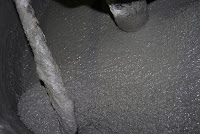 Building rubble or demolition material is a very valuable raw material
today, its reuse (upcycling), in our opinion, a very important step for
sustainability, reduction of raw material requirements, energy reduction
in production and reduction of CO2.
Building rubble or demolition material is a very valuable raw material
today, its reuse (upcycling), in our opinion, a very important step for
sustainability, reduction of raw material requirements, energy reduction
in production and reduction of CO2.
Many architects and
designers already work in their designs with materials that have become
interesting building materials again through upcycling. Old makes new.
In
Europe there are more and more companies that have specialized in the
processing of used building materials. You are preparing demolition
material for a new use in your own plant or already on the construction
site. The demolition material is sorted and broken according to quality
and color.
In conjunction with our HPC or UHPC binder systems, old
building materials obtained through demolition are transformed into
interesting new building materials with amazing properties.
The
sorted and broken waste material is processed with an HPC binder
material for later use as an aggregate in a very simple work step. After
processing, the demolition material is suitable for processing with HPC
or UHPC binder material and water into high-quality concrete, mortar
and floor coverings. Plastics, rubber, porcelain and glass can also be
processed as aggregates.
New floor coverings can be produced from milled asphalt road surfaces in a few simple operations. This
processing process could be carried out directly on site with the appropriate screening and mixing machines.
WPE DK International
Phone: 0049 176 601 73146
E-mail: ber@wpe-dk.dk
Homepage: www.wpe-dk.com

















































